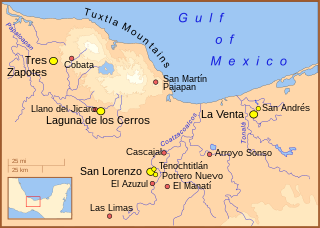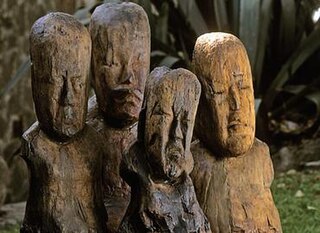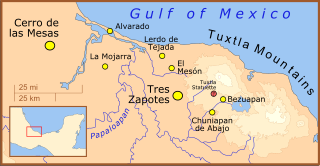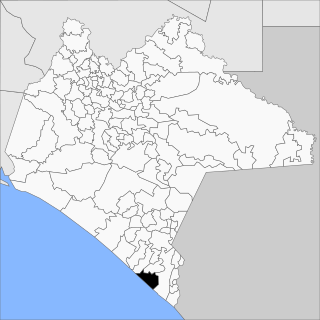
The Olmecs were the earliest known major Mesoamerican civilization. Following a progressive development in Soconusco, they occupied the tropical lowlands of the modern-day Mexican states of Veracruz and Tabasco. It has been speculated that the Olmecs derived in part from the neighboring Mokaya or Mixe–Zoque cultures.

La Venta is a pre-Columbian archaeological site of the Olmec civilization located in the present-day Mexican state of Tabasco. Some of the artifacts have been moved to the museum "Parque - Museo de La Venta", which is in nearby Villahermosa, the capital of Tabasco.

Tres Zapotes is a Mesoamerican archaeological site located in the south-central Gulf Lowlands of Mexico in the Papaloapan River plain. Tres Zapotes is sometimes referred to as the third major Olmec capital, but the Olmec phase is only a portion of the site's history, which continued through the Epi-Olmec and Classic Veracruz cultural periods.

Los Tuxtlas is a region in the south of the Mexican state of Veracruz.

San Lorenzo Tenochtitlán or San Lorenzo is the collective name for three related archaeological sites—San Lorenzo, Tenochtitlán and Potrero Nuevo—located in the southeast portion of the Mexican state of Veracruz. Along with La Venta and Tres Zapotes, it was one of the three major cities of the Olmec, and the major center of Olmec culture from 1200 BCE to 900 BCE. San Lorenzo Tenochtitlán is best known today for the colossal stone heads unearthed there, the greatest of which weigh 28 metric tons or more and are 3 metres (9.8 ft) high.

El Azuzul is an Olmec archaeological site in Veracruz, Mexico, a few kilometers south of the San Lorenzo Tenochtitlán complex and generally considered contemporary with it. Named for the ranch on which it is located, El Azuzul is part of the Loma del Zapote complex. The site occupies the higher elevations north of the confluence of two ancient river courses, a part of the Coatzacoalcos River system. It is upstream of the monumental earthworks at Potrero Nuevo, which is part of the San Lorenzo complex.

Cerro de las Mesas, meaning "hill of the altars" in Spanish, is an archaeological site in the Mexican state of Veracruz, in the Mixtequilla area of the Papaloapan River basin. It was a prominent regional center from 600 BCE to 900 CE, and a regional capital from 300 CE to 600 CE.

The Cascajal Block is a tablet-sized writing slab in Mexico, made of serpentinite, which has been dated to the early first millennium BCE, incised with hitherto unknown characters that may represent the earliest writing system in the New World. Archaeologist Stephen D. Houston of Brown University said that this discovery helps to "link the Olmec civilization to literacy, document an unsuspected writing system, and reveal a new complexity to [the Olmec] civilization."

The Olmec heartland is the southern portion of Mexico's Gulf Coast region between the Tuxtla mountains and the Olmec archaeological site of La Venta, extending roughly 80 km inland from the Gulf of Mexico coastline at its deepest. It is today, as it was during the height of the Olmec civilization, a tropical lowland forest environment, crossed by meandering rivers.
The causes and degree of Olmec influences on Mesoamerican cultures has been a subject of debate over many decades. Although the Olmecs are considered to be perhaps the earliest Mesoamerican civilization, there are questions concerning how and how much the Olmecs influenced cultures outside the Olmec heartland. This debate is succinctly, if simplistically, framed by the title of a 2005 The New York Times article: “Mother Culture, or Only a Sister?”.

El Manatí is an archaeological site located approximately 60 km south of Coatzacoalcos, in the municipality of Hidalgotitlán 27 kilometers southeast of Minatitlán in the Mexican state of Veracruz. El Manatí was the site of a sacred Olmec sacrificial bog from roughly 1600 BCE until 1200 BCE.

Classic Veracruz culture refers to a cultural area in the north and central areas of the present-day Mexican state of Veracruz, a culture that existed from roughly 100 to 1000 CE, or during the Classic era.

San Martín Pajapan Monument 1 is a large Olmec basalt sculpture found on top of the San Martin Pajapan volcano, in the Tuxtla Mountains of the Mexican state of Veracruz. It is notable for its original location and its Olmec iconography.

The Epi-Olmec culture was a cultural area in the central region of the present-day Mexican state of Veracruz. Concentrated in the Papaloapan River basin, a culture that existed during the Late Formative period, from roughly 300 BCE to roughly 250 CE. Epi-Olmec was a successor culture to the Olmec, hence the prefix "epi-" or "post-". Although Epi-Olmec did not attain the far-reaching achievements of that earlier culture, it did realize, with its sophisticated calendrics and writing system, a level of cultural complexity unknown to the Olmecs.
Olmec hieroglyphs designate a possible system of writing or proto-writing developed within the Olmec culture. The Olmecs were the earliest known major Mesoamerican civilization, flourishing during the formative period in the tropical lowlands of the modern-day Mexican states of Veracruz and Tabasco. The subsequent Epi-Olmec culture, was a successor culture to the Olmec and featured a full-fledged writing system, the Isthmian script.

Villa Mazatán (Spanish pronunciation:[ˈβiʝamasaˈtan] is a municipality in the Mexican state of Chiapas in southern Mexico. It has an area of 386.6 km ² and is located in the southwestern Mexican state.
La Joya is a Mesoamerican prehispanic archeological site, located in the municipality of Medellín in central Veracruz, Mexico, about 15 kilometers from the port of Veracruz, near the confluence of the Jamapa and Cotaxtla Rivers.

Las Choapas is a recently found archaeological site located within the municipality of Las Choapas, in the southeastern border of the Veracruz State, inside the San Miguel de Allende Ejido, bordering the municipalities of Huimanguillo, Tabasco and Ostuacán, in Chiapas.

The Olmec colossal heads are stone representations of human heads sculpted from large basalt boulders. They range in height from 1.17 to 3.4 metres. The heads date from at least 900 BC and are a distinctive feature of the Olmec civilization of ancient Mesoamerica. All portray mature individuals with fleshy cheeks, flat noses, and slightly-crossed eyes; their physical characteristics correspond to a type that is still common among the inhabitants of Tabasco and Veracruz. The backs of the monuments often are flat. The boulders were brought from the Sierra de Los Tuxtlas mountains of Veracruz. Given that the extremely large slabs of stone used in their production were transported over large distances, requiring a great deal of human effort and resources, it is thought that the monuments represent portraits of powerful individual Olmec rulers. Each of the known examples has a distinctive headdress. The heads were variously arranged in lines or groups at major Olmec centres, but the method and logistics used to transport the stone to these sites remain unclear. They all display distinctive headgear and one theory is that these were worn as protective helmets, maybe worn for war or to take part in a ceremonial Mesoamerican ballgame.












